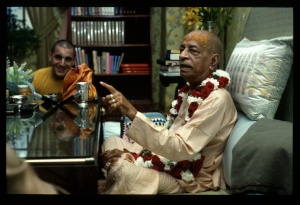CC Adi 11.24

A.C. Bhaktivedanta Swami Prabhupada
TEXT 24
- kamalākara pippalāi—alaukika rīta
- alaukika prema tāṅra bhuvane vidita
SYNONYMS
kamalākara pippalāi — Kamalākara Pippalāi; alaukika — uncommon; rīta — behavior or pastime; alaukika — uncommon; prema — love of Godhead; tāṅra — his; bhuvane — in the world; vidita — celebrated.
TRANSLATION
Kamalākara Pippalāi is said to have been the third gopāla. His behavior and love of Godhead were uncommon, and thus he is celebrated all over the world.
PURPORT
Śrīla Bhaktisiddhānta Sarasvatī Ṭhākura writes in his Anubhāṣya, “In the Gaura-gaṇoddeśa-dīpikā (128) Kamalākara Pippalāi is described as the third gopāla. His former name was Mahābala. The Jagannātha Deity at Māheśa in Śrī Rāmapura was installed by Kamalākara Pippalāi. This village of Māheśa is situated about two and a half miles from the Śrī Rāmapura railway station. The genealogy of the family of Kamalākara Pippalāi is given as follows. Kamalākara Pippalāi had a son named Caturbhuja, who had two sons named Nārāyaṇa and Jagannātha. Nārāyaṇa had one son named Jagadānanda, and his son’s name was Rājīvalocana. During the time of Rājīvalocana, there was a scarcity of finances for the worship of the Jagannātha Deity, and it is said that the Nawab of Dacca, whose name was Shah Sujā, donated 1,185 bighās of land [about 395 acres] in the Bengali year 1060 [A.D. 1653]. The land being the possession of Jagannātha, the village was named Jagannātha-pura. It is said that when Kamalākara Pippalāi left home his younger brother Nidhipati Pippalāi searched for him and in due course of time found him in the village of Māheśa. Nidhipati Pippalāi tried his best to bring his elder brother home, but he would not return. Under these circumstances, Nidhipati Pippalāi, with all his family members, came to Māheśa to reside. The members of this family still reside in the vicinity of the Māheśa village. Their family name is Adhikārī, and they are a brāhmaṇa family.
“The history of the Jagannātha temple in Māheśa is as follows. One devotee of the name Dhruvānanda went to see Lord Jagannātha, Balarāma and Subhadrā at Jagannātha Purī, wanting to offer food to Jagannāthajī that he had cooked with his own hands. This being his desire, one night Jagannāthajī appeared to him in a dream and asked him to go to Māheśa on the bank of the Ganges and there start worship of Him in a temple. Thus Dhruvānanda went to Māheśa, where he saw the three deities—Jagannātha, Balarāma and Subhadrā—floating in the Ganges. He picked up all those deities and installed them in a small cottage, and with great satisfaction he executed the worship of Lord Jagannātha. When he became old, he was very anxious to hand over the worship to the charge of someone reliable, and in a dream he got permission from Jagannātha Prabhu to hand it over to a person whom he would meet the next morning. The next morning he met Kamalākara Pippalāi, who was formerly an inhabitant of the village Khālijuli in the Sundaravana forest area of Bengal and was a pure Vaiṣṇava, a great devotee of Lord Jagannātha; thus he immediately gave him charge of the worship. In this way, Kamalākara Pippalāi became the worshiper of Lord Jagannātha, and since then his family members have been designated as Adhikārī, which means ‘one who is empowered to worship the Lord.’ These Adhikārīs belong to a respectable brāhmaṇa family. Five types of upper-class brāhmaṇas are recognized by the surname Pippalāi.”